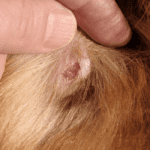- Nom Nom Dog Food Subscription Review - November 7, 2023
- 7 Best Dog Bed Ideas For Great Dane (DIY Options) - July 16, 2022
- Top 5 Rated Best Non-Prescription Diabetic Dog Food - July 15, 2022
Fido wakes up in the morning feeling excited to go to the dog park and meet new friends. His owner watches him as he runs around chasing other dogs. He’s having a great time but eventually is ready to head home. When he leaves the park, his owner notices that he is limping. His owner waits to see if it heals on its own, and although it looks better after a few days, she decides to take him to the vet anyway.
The vet tells the owner that Fido has a tear in what’s called a Cranial Cruciate Ligament, where the ligament that stabilizes the knee joint tears or ruptures. This can occur through a sudden injury (acute) or over time (chronic) with symptoms appearing suddenly. Although common, it can be very painful for the dog. The vet recommends that Fido have surgery, and now the owner must make a decision on what to do.
What is a Cranial Cruciate Ligament?
A ligament is a band of tissue that connects two bones at a joint.The cranial cruciate ligament specifically connects the thigh bone with the lower leg bone. This is also referred to as anterior cruciate ligament (ACL.) Cranial Cruciate Ligament Disease is the sudden or gradual failure of the ligament and is the most common cause of rear-leg lameness and degenerative joint disease. The severity of this condition depends on if it is a partial rupture or a complete rupture. The type of rupture also indicates whether it was an acute or chronic condition.
A major sign that the dog may have a torn ligament is if he is holding the leg in a partially bent position while standing, and the weakening of muscles (muscle atrophy) in the rear leg is a sign that the leg is not being used properly. Certain breeds are more prone to ligament injuries, such as Labrador Retrievers, Newfoundlands, German Shepherds, Rottweilers, and Golden Retrievers.
Although it is not as prevalent in mixed breeds, they are not immune to it either. It is also common in obese animals that occasionally get strenuous exercise. Studies show that 5% of males neutered before 12 months and 8% of females develop ligament injuries later in life and that half the dogs that rupture a ligament in one leg will develop the condition in the other leg.
The diagnosis is made by observing abnormal movement in the joints. A veterinarian will apply pressure on the knee and will feel the bones move abnormally in what is called a “drawer sign.” This term refers to the movement of the leg as like pulling and pushing a drawer in and out of its cabinet.
How is This Condition Treated?
Most likely, the dog will need surgery to treat the ligament tear, although there are different surgical options, depending on the dog’s activity level, size, age, and the degree of the rupture. A small number will heal with conservative therapy. This involves weeks of cage rest with brief walks only for bathroom breaks. Some vets will place knee braces or prescribe anti-inflammatory medication, but these are often ineffective. Following surgery, ice packs and physical therapy will help improve the dog’s condition.
There are a few options for the type of surgery the vet performs. One procedure involves using synthetic material to recreate the ligament. The other option is a procedure where the tibia is cut, moved, and reattached using plates and screws. This is a difficult surgery but shows excellent results. It’s especially recommended for dogs over 50 pounds. A third choice is to cut a different portion of the tibia so it heals at a different angle to change the mechanical stresses of the joint. Arthritis can occur if the joint is left untreated.
How Much Does Treatment Cost?
If the owner does decide to move forward with surgery, the range in cost can be anywhere from $1,200 to $4,600. Outside of surgery, you can expect to spend about $300 for the initial vet visit and then a follow-up visit to make sure the surgery went well. Below is a breakdown of what to keep in mind when deciding if you want to pay for surgery.
Invasive surgery:
$1,200 to $4,600
Physical therapy:
-Initial consultation: $100-$200
-This covers Physical Exam, Neurological Exam, and Gait Analysis
-Subsequent visits: $35-$80 per session, $500-$1,500 for end-to-end therapy
-E-collar/cone: $15
-Hot/cold compress: $15
-Crate: $30-$100 depending on size of dog
-Knee brace: $150-$800 depending on brand
-Harness: $25-$60
-Joint supplies: $30-$80
-Puzzles/toys: $15-$20
If surgery is not an option for you, you can go the route of what is called “conservative management”. This is not necessarily cheaper, but some owners may prefer not to put their canines through surgery. As stated earlier, these treatments are not as effective as surgery, but some actions you can take are:
-Weight loss
-Knee braces and/or harness devices
–Glucosamine and/or chondroitin supplements
-Prolotherapy (injecting sugar water or other benign substances)
-Acupuncture and massage
Plans Coverage Comparison of Cranial Cruciate Ligament
After talking to the vet and weighing the options, the owner has decided that Fido should get surgery. Before doing this, she wants to look into different pet insurance companies to compare their rates and see what would potentially be covered.
Some of the options she finds are:
Healthy Paws Insurance: This covers any illness or accident as long as it is not a pre-existing condition. For dogs that are 5 years old and younger, 80% is the most popular reimbursement option with a $250 deductible plan. This breaks down to a rate of $31.34 a month. One thing to be careful of, however, is if your dog was showing any signs of ligament problems before enrollment or during the 15-day waiting period, it would be considered a pre-existing condition and therefore not covered. Below is an example of their insurance claim, and you can view their full policy here.
Healthy Paws Insurance Claim:
You noticed that your little dog’s back legs seem wobbly
You’re not sure what’s wrong, but there seems to be a problem with your dog’s back or back legs. When standing, he falls to one side and walks kind of funny. You take him to your primary veterinarian for evaluation.
Your Vet’s Diagnosis: Back pain, suspect IVDD. Refer to a Specialist. Prepare to have costly vet bills.
Pet Plan Pet Insurance: This covers a wide variety of issues, including illness/injury, vet exam fees, and hereditary conditions. However, this plan does not cover treatment of torn ligaments if the signs occur during the first six months that the policy is in effect. Coverage will be afforded if your pet is examined by a vet within the first thirty days of the policy and the medical records specifically note your pet does not have any pre-existing conditions relating to the knees. For more information on this, you can view their full policy.
Embrace Pet Insurance: Embrace policies can be personalized to fit any budget. For example, you might want 90% reimbursement with a $500 deductible or 80% reimbursement with a $200 deductible. Every pet enrolled has the same comprehensive coverage. In one instance, say surgery costs $3,125.41. With an annual deductible of $200 and a 20% co-pay of $570.06, the total reimbursement is $2,280.23. If a second repair was needed, it would not have an additional deductible. In another instance, if the vet bill was $6,989.99 with an annual deductible of $100 and a 10% co-pay of $635.75, your reimbursement would be $5,721.77 . Once again, however, Embrace does not cover the surgery for a torn ligament if the accident occurred prior to purchasing insurance, as this is considered a pre-existing condition.
Nationwide: There are three types of coverage if you decide to go with Nationwide, starting at $65 a month, $35, and $18, respectively. Once again, it does not cover pre-existing conditions. However, if you have medical records from your vet showing that your dog’s condition has been cured for at least six months, you may be able to get it covered. The major problem is that if your dog has an injury to its cruciate ligament within the first year you are insured, it won’t be covered.
Pet First Pet Insurance: This plan has a 12-month policy period, but you can upgrade, downgrade, or cancel at any time. The pet must be at least eight weeks old but there are no age restrictions after that. As with the others, this insurance does not cover torn ligaments within the first twelve months. However, Pet First has several plan options and covers many common conditions, such as accidents and illnesses, hereditary, congenital and chronic conditions, cruciate ligaments (after the 12 months), periodontal disease, hip dysplasia, and cancer.
Pets Best Health Insurance: With this insurance, you have a choice of 70%, 80%, or 90% reimbursement with an annual deductible between $50 and $1,000. This is also a 12-month contract with a 14-day waiting period and no lifetime limits. Pre-existing conditions are not covered and most other conditions are only covered as long as they were not present before the effective date of the policy. Dental is only covered if it is due to an illness or accident, and they will not cover items deemed “preventable.” There are three plans – Essential, Plus, and Elite, and Plus is the most popular choice.
Should I have Pet Insurance for this Condition?
Unfortunately for Fido’s owner, most insurance companies will not cover the surgery if she has not already enrolled. Her bill is going to be costly, but it’s essential that Fido heals. She decides to enroll in an insurance plan to prevent these out-of-pocket costs in the future. In many cases, if one leg suffers a torn ligament, there is a higher chance that the other leg will also tear at some point. If she enrolls now, the waiting period will be short enough that insurance will cover the cost if a second surgery is needed in the future.
Considering the cost of owning a pet – routine vet visits, accidents, illnesses, medications – the price of insurance outweighs the price of a sick dog.
So which insurance company should you go with? That really depends on preference. There will be similarities with all of them. For example, none of them seem to cover pre-existing conditions or any accidents or illnesses that occurred prior to the enrollment. You can request a free quote for each one that is catered to your dog so that you can decide what the best route is for you.
If you know of any other insurance companies not listed in this article, feel free to post them in the comments section!
Continue reading:
Does Pet Insurance Cover Vaccinations? (Costs)




